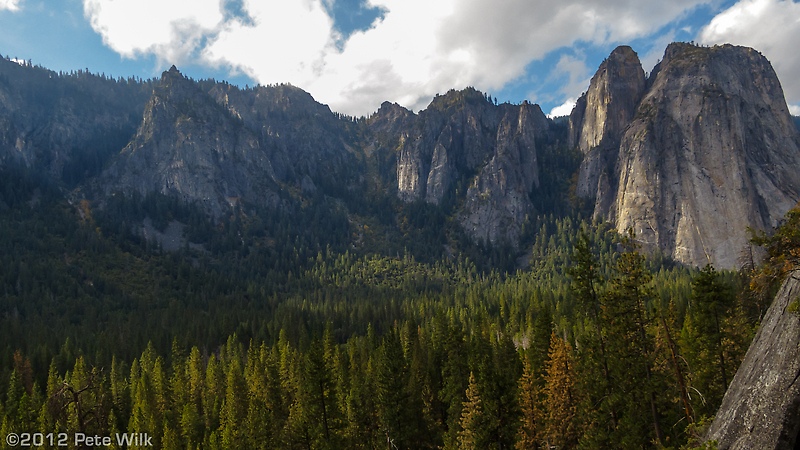
Climbers and non-climbers alike recognize that Yosemite Valley is rock climbing’s mecca. This has recently been underscored by the media coverage (Nat Geo & 60 Minutes) of Alex Honnold and his amazing free solo ascents of El Capitan and Half Dome. It was further emphasized by his and Hans Florin’s record-breaking speed ascent (a mind blowing 2 hours 23 minutes) of the Nose on El Cap, a route that takes an average party 3-4 days. Yosemite’s long history is an amazing one and if you haven’t seen the Ken Burns documentary on the National Parks I highly recommend it. I haven’t seen all of the episodes but his coverage of Yosemite is great. Knowing all of the hard work that many people put into protecting this amazing place made me appreciate it more while I was there.
Speaking of which how did I come to visit The Valley, as it is called? Back in the early spring I joined the American Alpine Club (AAC) and noticed they had an invitational climbers meet in Yosemite. I thought this would be a great experience so I filled out the application for the International Climbers Meet (ICM). In late July or early August I got a message saying I was accepted. The details of the meet were pretty sweet: Pickup at Fresno airport, transportation in the park, camping and meals covered, all for $450. Not to mention experienced host climbers to help participants select climbs–pretty awesome way for a Valley virgin such as myself to be introduced to climbing there. …
For once procrastination paid off for me. I didn’t buy a plane ticket from NYC to FAT for a long time. Just after coming back from the Tetons the ball was in motion for me to move to Salt Lake City. Part of my discussion with Black Diamond was that, yes I can start at the end of September but by the way I’m going on a week vacation at the beginning of October, which was fine for them. My ticket from Salt Lake to Fresno was not too much different in price that one from NYC unfortunately, but it was considerably shorter, only 1.5 hours.
Getting on the plane in SLC I noticed a few other climber looking types boarding the plane with me. You know the look, could be any combination of plaid short sleeve shirts, disheveled looks, technical carry on luggage, and weathered hands. I didn’t try to make small talk since I’m not a huge fan of it on planes. Arriving in Fresno I walked to the described meeting area to see that all the climber types on the plane with me were also there for the AAC trip. Carol from the AAC greeted us and quickly began organizing vans for us to get in for the drive to the Park.
The goal of the ICM is to bring international climbers and US together to foster camaraderie and community amongst a wide variety of climbers. The climbers I shared the van with quickly pursued this goal and in short time we were all well acquainted with each other and with Carol the AAC organizer who was driving.
We were one of the later vans and we arrived after dark–my typical standard operating procedure for visiting amazing places. As such there was no build up of seeing the rock cathedrals of Yosemite from afar. Not that even in daylight there is much either. The last bit of road from Fresno to Yosemite is a tight, windy, slow road. The road is encroached by tall trees and there isn’t much chance to see the Valley, aside from the iconic viewpoint at the tunnel, but since it was dark we didn’t see anything. Once in the park and driving towards Yellow Pines campground, we could just make out the silhouettes of the towering walls on either side. At one point we could make out blinking stars on the left hand side of the car, though they seemed low to be stars. At closer inspection they were not stars but headlamps of people on El Capitan.
Since the AAC has a good relationship with the Park they allow us to stay at Yellow Pines campground, which is a service volunteer campground. Visitors here have to pledge a few days of volunteer work in order to be granted permission to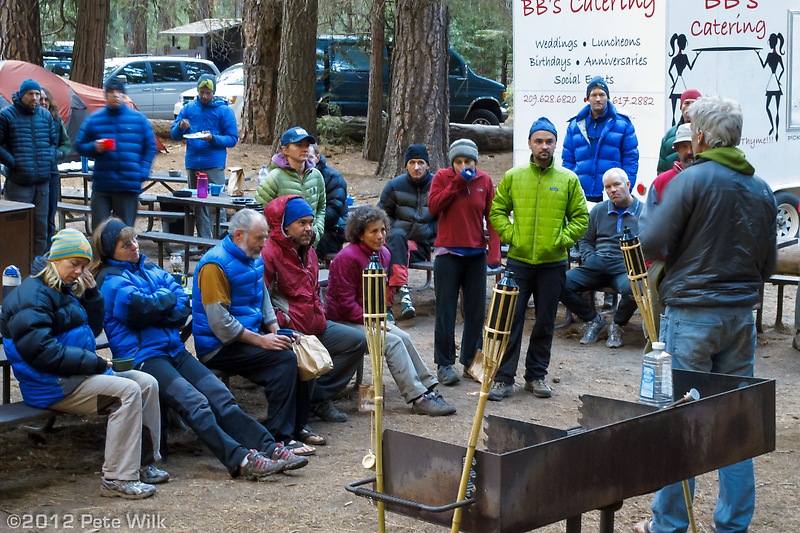 use the campground, which is quite nice. Our agreement allowed us to do only one day of service for the 7 we’d be there. After some introductions most of us settled in for some rest.
use the campground, which is quite nice. Our agreement allowed us to do only one day of service for the 7 we’d be there. After some introductions most of us settled in for some rest.
Monday morning we were treated to our first of many catered meals. It wasn’t extravagant, just a breakfast sandwich on a croissant, but we didn’t have to do much cleaning, just our personal plate and utensil. Soon the little brown bag lunches started being laid out and everyone quickly flashed backed to elementary school. Carol called everyone together and a few of the climbers from Nepal made a blessing wishing us good luck on our climbing for the next week and bestowed silk scarves on us. While the Nepalese wouldn’t be staying for the week they wanted to provide us with some exposure to their cause, which is the Everest Summiteers Association. The group is responsible for hauling over a thousand tons of trash from the slopes of Mt. Everest.
After the blessing we were assigned to a host climber who would be responsible for knowing what climbs we’d attempt during the week. The first day, to foster a little more familiarity amongst the group we all went cragging, but at different spots for every few hosts. At Churchbowl crag I met a number of interesting people, Fiona from South Africa, Julie from Climbing magazine, re-acquainted with Keith from the Tetons, Pete from Washington, Jeff from Idaho, Steve from California, and Michael our host as well as others. A number of routes were lead and top ropes set up for all to cut their teeth on the famous Yosemite granite. I found the first few routes to be slightly more difficult for the grade than I would have imagined, but since I hadn’t climbed in 3-4 weeks, I believe it was being out of shape rather than the routes being sandbagged.
Luckily I have climbed on some amount of granite, certainly not a ton but some at least. The style of crack was not unknown to me because of my pitches on Cathedral Ledge and Cannon Mtn in New Hampshire. Still it was a little different, I felt as though the friction wasn’t quite as good, but this might be due to the larger amount of traffic in the Valley. The features tended to wider cracks as well, which is a well-known feature of routes in the Valley. Of the routes climbed the last one, Bishop’s Terrace (5.8), was by far the best. The second of the two pitches was the better with some perfect straight in hand jams on clean white stone.
We returned to camp for a big dinner and some brews. Unfortunately they were only PBRs but they were good enough, and full strength, something slightly more difficult to come by here in Utah. Over headlamp and lantern light more introductions and new friends were made. A white board went up for people to list their partner or transportation requests and plans were cemented for Tuesday.
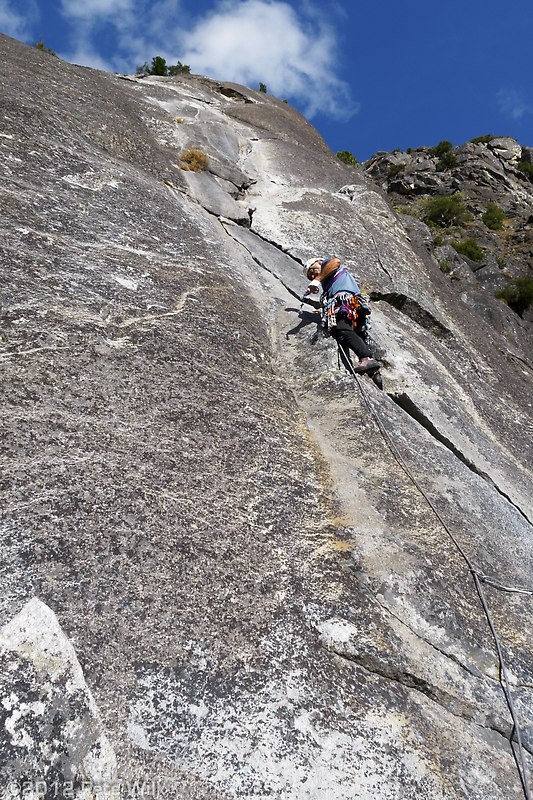 I decided to head out with Pete from Spokane, WA on Tuesday to climb a five-pitch route called Nutcracker (5.8). It is a Valley classic and was recommended by Boris. The route is a perfect small outing and there are plenty of other climbs at the Manure Pile Buttress to fill out the day if necessary. Pete and I got a pretty good start on the climb and were the first ones on even though it was 9:30 or so. I lead up the first 5.7 pitch and was glad to pull through the crux. The first pitch of the standard route is a left facing corner, which requires a lot of laybacking because of the lower angle. The gear is pretty good the whole way. Near the top, perhaps 70 ft up, the corner starts to arch more left and causes the laybacks to get steeper, once you pull around right it is easier. I set the belay and brought Pete up. He continued up the second pitch was no more than a steep ramp requiring no gear. Since this wasn’t much of a pitch it made sense for Pete to lead the next pitch as well.
I decided to head out with Pete from Spokane, WA on Tuesday to climb a five-pitch route called Nutcracker (5.8). It is a Valley classic and was recommended by Boris. The route is a perfect small outing and there are plenty of other climbs at the Manure Pile Buttress to fill out the day if necessary. Pete and I got a pretty good start on the climb and were the first ones on even though it was 9:30 or so. I lead up the first 5.7 pitch and was glad to pull through the crux. The first pitch of the standard route is a left facing corner, which requires a lot of laybacking because of the lower angle. The gear is pretty good the whole way. Near the top, perhaps 70 ft up, the corner starts to arch more left and causes the laybacks to get steeper, once you pull around right it is easier. I set the belay and brought Pete up. He continued up the second pitch was no more than a steep ramp requiring no gear. Since this wasn’t much of a pitch it made sense for Pete to lead the next pitch as well.
Pete stepped right and gained a nice crack system and incidentally some good exposure now that we were out of the trees and away from the bigger ledges. On the next pitch I had an exciting few moves left around a bulge with little protection, this was over fairly quick and since I’m a decent face climber, wasn’t too stressful. From there I followed a crack system and got to a good belay below a steep headwall about 10 feet high. This is the “mantle move” pitch. Pete scampered up and quickly sewed up some pro in the small placements available. Unfortunately the pro is only keeping you on the cliff not preventing injury in this case. A fall from the headwall would send you down onto the lower angled section below, with high probability of a busted ankle. None of this was to deter Pete and he made it through the mantle using a heel hook and quickly was cruising the rest of the pitch to the top. I performed a similar move and joined my partner on the top for some lunch. We topped out in 2:45 minutes, which was pretty much right in the middle of the time estimates for the route.
Scrambling down the backside of the Manure Pile we decided another climb was necessary as we had lots of energy and time to climb again. This time we chose another multi pitch route called C.S. Concerto (5.8), this route wasn’t as long, but turned out could be linked to the summit again. Pete headed up the first pitch and I the second. P2 had a similar a couple mantle moves near the top of the pitch and with little gear. From there Pete headed up the third and final pitch. A party in front of us linked a pitch after P3 with After Six and continued to the top. A party on After Six joined Pete at his stance at the top of P3 and he contemplated waiting for them to go up before continuing. Seeing that they weren’t moving too quickly and that there were three of them I called up to go around to the right and follow the first party, thereby getting in front of the party of three. After a minute of studying the alternate line he headed up and we were able to get to the next belay before the other party. Not wanting to get caught again, I quickly climbed and grabbed what little of the rack was left and motored to the top. Thank god for 70m ropes to link up pitches! At the top we caught up with some other AAC ICM climbers just finishing After Six as well.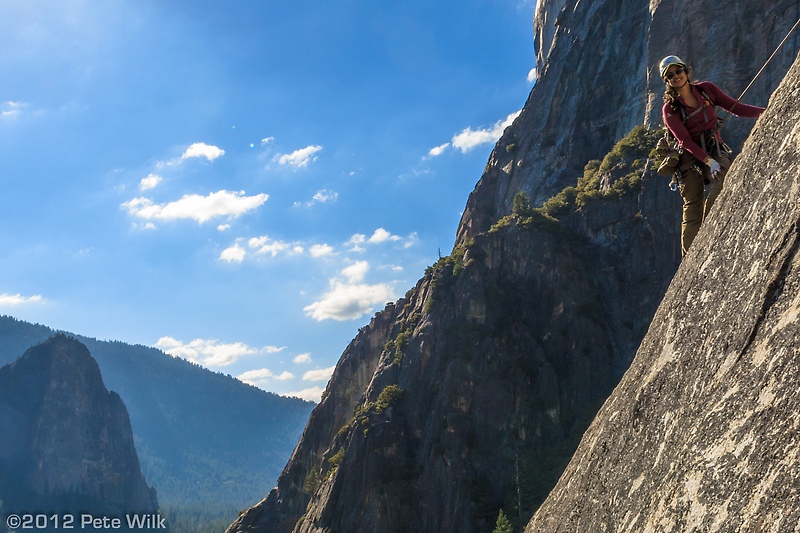
Earlier that morning we had been dropped off and were without a car to return to camp. However it is only a couple miles so we decided to walk, it would be a good chance to check out Camp 4 up close as well. For those non-climbers out there, Camp 4 is the legendary campground where the history of Yosemite climbing was forged. Every Yosemite climbing icon has spent time usually months or years there, Robbins, Bridwell, Salathe, Chouinard, Steck, Harding, and many others, their names are found in guidebooks around the country as first ascentionists. It is the cheapest campground in the Valley and is by first come, first served basis, which makes it a favorite of current climbers as well. It is even in the register of National Historic Places. On top of that it is home to one of the most well known bouldering problems in the world, Midnight Lightning (V8).
However, most recognizable is that Camp 4 is a dump of a campground. Not to say it is plagued with discarded rubbish, unless you count what some tourists might consider the climbers, rather it is just not a great campground as far as scenery or amenities. The campground has a parking lot and no driveways to link sites; this requires you to walk your gear from car to tent. There is no grass, no showers, and no privacy in the sites. Sites house up to six people and from the looks of it, six is not the max, it is the standard. The line to register for sites forms early and sites can be filled long before everyone in line has gotten a spot. It bares the resemblance of a tent city disaster zone in third world but with Marmot, The North Face, and Black Diamond tents. When all is said and done, I will end up staying here at some point in the not distant future. Despite its shortcomings it is a place that every climber should experience in their career.
Wednesday the AAC organized an off-width clinic with Rob Pizem, one of our host climbers. Despite having a “real” job and a family Rob gets out and crushes on a regular basis and has sponsorship to help fund his first ascending trips. He is one of the best off-width climbers out there and I had a hard time deciding to pass up his clinic to climb with John Bragg. John was the senior member of the AAC board on hand for the week. Though currently in Colorado he spent much of his younger days (1970’s) in the Northeast and put up some amazing climbs there and in other areas, such as in Patagonia (Torre Egger and Cerro Torre). He was part of the second ascent party up the Black Dike (NEI5). He also has two other iconic New Hampshire ice climbs to his name, Dracula (NEI4) and Repentance (NEI5). In addition to ice he also put up routes on rock, Kansas City (5.12b), Gunks; Fat City Direct (5.10d), Gunks; Vertigo (5.9 A0), Cannon Mtn.; and The Ghost (5.7 A3), Cannon Mtn. This is but a small list of John’s accomplishments. His climbs in the Northeast are on every climber’s ticklist.
John and I headed out for some cragging and spent the late morning at Highway Star that has a 60 ft 5.10 we both lead as well as hard variation. In the afternoon we moseyed up to Little Wing, a secluded crag about a 30-minute walk up an ancient road. The road, while paved at one time, is quickly returning back to its natural state. Boulders and trees sit on or come through it in many places. It is reduced to slightly more than a double track trail at best, or unrecognizable at worst. The road leads up from the base of El Cap and provides a great vantage point for the Bridalveil Falls, which were not even making it to the ground this late in the season. After a bit of bushwhacking we found the start of our desired route, Leisure Time (5.10b). John took the lead and worked his way through a tricky start to a thin crack to steep face holds and some good jams before getting into a short flaring chimney–a very nice climb in a great area.
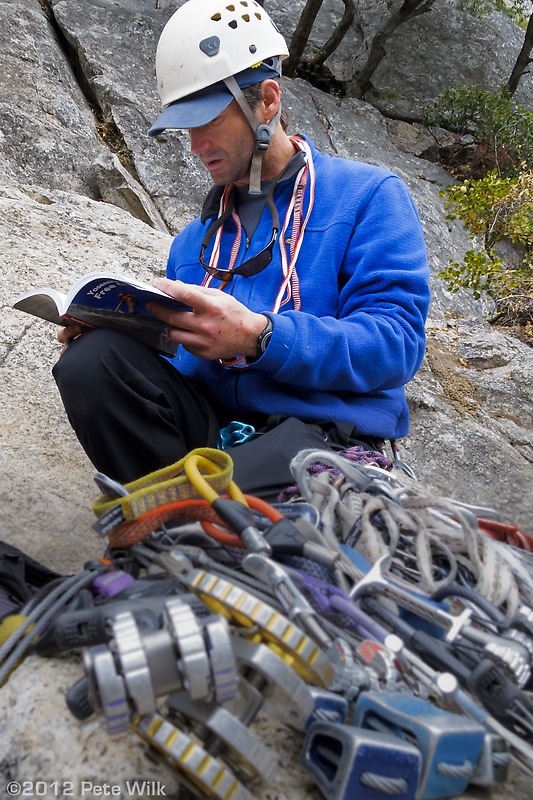 Thursday brought overcast skies and the chance of rain. Steve, Michael, and I headed off to Commitment (5.9). This three-pitch route is pretty classic and usually has a fair amount of traffic. Luckily, being a weekday and weather a bit threatening, there was no one on it. Steve headed up the first pitch. We played musical ropes and I headed up the second pitch that had some good liebacking in a right facing corner. Just after Michael started heading up the third pitch we felt some drops. The crux of the route is the third pitch hand traverse under a roof. I’ve done these moves on many climbs before where you move under the roof and skyhook a hand around the corner and there is a jug. This route was no different, except I couldn’t seem to make these moves 5.9. I fumbled the hand sequence and couldn’t quite seem to get over to the roof for the skyhook. Not sure what I messed up but I got through and spent more energy than needed. Just as we topped out the rain started to fall a bit more. The decent was a little tricky in places but not terrible. Since Steve was jetting off to Stockholm for a conference, he’s a physics professor, Michael and I headed back to camp.
Thursday brought overcast skies and the chance of rain. Steve, Michael, and I headed off to Commitment (5.9). This three-pitch route is pretty classic and usually has a fair amount of traffic. Luckily, being a weekday and weather a bit threatening, there was no one on it. Steve headed up the first pitch. We played musical ropes and I headed up the second pitch that had some good liebacking in a right facing corner. Just after Michael started heading up the third pitch we felt some drops. The crux of the route is the third pitch hand traverse under a roof. I’ve done these moves on many climbs before where you move under the roof and skyhook a hand around the corner and there is a jug. This route was no different, except I couldn’t seem to make these moves 5.9. I fumbled the hand sequence and couldn’t quite seem to get over to the roof for the skyhook. Not sure what I messed up but I got through and spent more energy than needed. Just as we topped out the rain started to fall a bit more. The decent was a little tricky in places but not terrible. Since Steve was jetting off to Stockholm for a conference, he’s a physics professor, Michael and I headed back to camp.
There we found a few others lounging around eating lunch and having a few beers. Both Michael and I refrained and hoped the weather would clear. Luckily after an hour and half the sun came back out. We headed to Pat and Jack crag, which has a great concentration of 5.9-5.10 climbs. At the crag already was a bunch of our fellow IMCers. We fired off a bunch of long mixed 5.8/5.9 routes. Heading back near the approach trail we did a 5.10b face climb with a wicked thin start. One of the interesting features of this wall is the knobs of granite that stick out. These are welcomed jugs and footholds. One of the best climbs at the crag was Knob Job (5.8) to Nurdle (5.10) linkup for two outstanding pitches of 5.8. Michael was kind enough to let me have the lead and I headed up, clove hitching a big knob along the way for pro. At this point it was getting pretty late in the afternoon and the sun, had it stayed out would have been setting. Michael followed the long pitch and we started heading down at dusk. We were a little late for dinner but at least we got a full day of climbing in despite the break in the middle of the day.
Friday morning we had a choice for our service project, pick up trash or trail maintenance on the El Capitan East Ledges descent trail. Being more interested in moving rocks around I signed up for trail maintenance. Again the rain and clouds came down and we were lucky in that we didn’t miss a day of climbing with our service day. The descent trail is a climber’s trail, which means there was no formal work or planning that went into it originally. As such it has poor erosion resistance and gets very loose in some spots. We hiked most of the way to the rappel on the trail and split off improving small sections. One of the Park Service trail workers helped us figure out what and where to do work as well as provided tools. It was a little difficult at first but after a 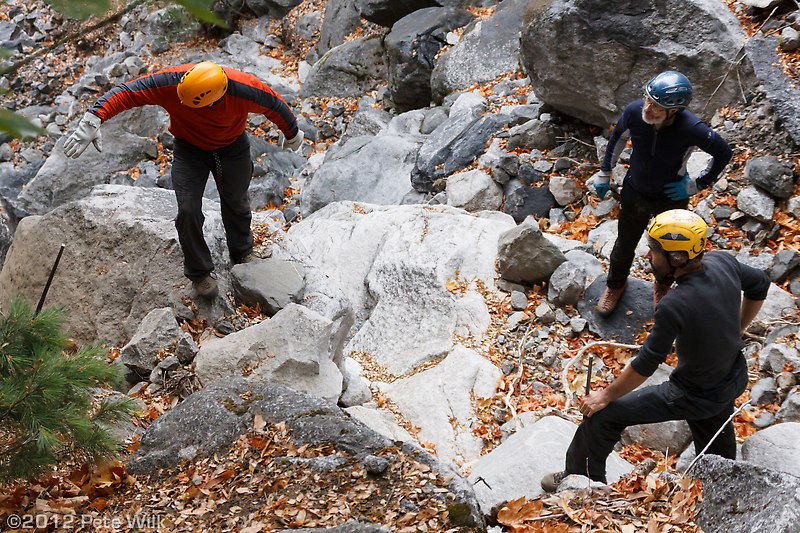 little while we all got the hang of how to move and place the rocks to improve the water run off. One of the hosts and I built a set of stairs on a section. Hopefully when I do El Cap in a couple years I’ll come down this trail and still find our work.
little while we all got the hang of how to move and place the rocks to improve the water run off. One of the hosts and I built a set of stairs on a section. Hopefully when I do El Cap in a couple years I’ll come down this trail and still find our work.
After the trail work was finished we had an early dinner and everyone moved off to an auditorium where Hans Florine would be giving a slideshow presentation. The AAC had organized this event and it was open to the public. When we arrived the seats were filling fast. Hans Florine is a longtime speed record chaser on the Nose of El Cap. As I mentioned at the beginning of this post most people take 3-4 days to do it, though relatively normal people commonly do it in less than 24 hours. Hans’ slideshow was a historical perspective of climbing the Nose. He showed the many times the record has been broken and by whom. I was very surprised at Hans. From the Reel Rock 6 the competition between Hans and Dean Potter was intense. The film portrayed Hans to be a bit more arrogant than I found him to be in the slideshow. He was well spoken, humble, self-deprecating, and respectful to all of his adversaries over the years who usually quickly broke his records. He is certainly a shameless self-promoter but he comes across as a nice guy. If you have the opportunity to see him speak I recommend going.
Saturday was the last climbing day. One of my new friends, Ted, and I planned the North East Buttress of Higher Cathedral (5.9). This is a grade IV climb, which basically means its long and will take a normal party a long day to complete. Anticipating this we headed off with a bunch of other climbers all going to the same parking area at 6am. We headed up the approach trail with two other members of the ICM, Paul and Dan. As the sun started to come up we got to the base of the route. Higher Cathedral rock sits opposite the valley from El Capitan; it is the highest of the three Cathedrals. To the east a canyon with two granite towers encloses the start of the NE Butt. The position provides great views of these two towers and the climbers on them.
I started off the first pitch that is only 5.7. It is ok with a lot of varied climbing with a couple wide moves that are a hint of things to come near the top. Ted and I were hoping to use the 70-meter rope to our advantage and out pitch Dan and Paul, however they were quicker climbers so we ended up getting to the halfway point of the route at the same time. At that point it made more sense for them to continue ahead. Up to this point the most notable climbing is the traverse, which includes a down climb. From here the route gets into its more physical and demanding climbing. The first portion from the traverse is a widening crack with good gear but awkward positioning. Some off-width moves were required but not much; Ted lead that pitch. I was up next and got to tackle the tight dihedral with good jams and pro in the back. However it was so tight that it was impossible for me to go into it straight so I had to sort of chimney up it. Not being all that familiar with chimney’s I pussed out and leap-frogged #2, #3, and #4 camalots up the squeeze which made things slow. I made it to a crappy belay at a bay bush, and brought Ted up—Quick aside, a live bay leaf fresh off the bush is an amazing smell. Those cardboard things you get from McCormick in the grocery store have no resemblance to a fresh bay leaf—Ted got to head up the next pitch which was similar except it had a proper squeeze chimney. Ted chose poorly and had his left side in when he should have had his right.
I headed up this pitch and with much effort got to the next belay, again pretty crappy. I picked up the gear and set out again, 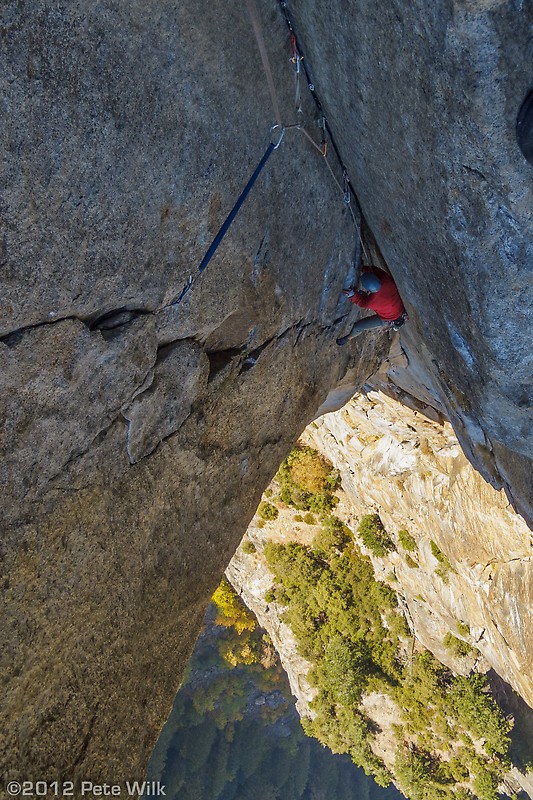 this time on lower angle but wider cracks. I think I placed a #5 but I can’t remember for sure. I remember getting to the top of the pitch and being glad I was out of the off-width stuff. I traversed to the left again and had a good belay. Ted followed quickly but got tripped up on a #1 camalot that got stuck. He worked at it for a while and gave up. Not wanting to lose one of my pieces I headed over and worked on it. Luckily I got it out. The next pitch was Ted’s and he began up. After what seemed like a while I looked up to see that he was only 40 feet up, I couldn’t really figure out why until I heard him say that he really liked that 5.10a off-fingers crack variation. Awesome, off-fingers are the worst size crack for me. I can’t seem to get ringlocks down which is the proper technique for this size. He continued for probably close to another 45 minutes. At which point I was pretty bored at the belay. The day was getting on pretty late and I wanted to be at the top so we wouldn’t be walking down in the dark. Finally and faintly I heard “off belay.” I got to the rattly fingers section and was able to power through, though just barely. I kept climbing. More physical off-width-ish style climbing awaited and I found out why I Ted took so long. He had strung the next two pitches together and pretty much hit the end of our 70-meter rope. This caused significant drag for him and he had to pull up slack to make a few moves, and then take more slack. At the end of this marathon pitch I was totally knackered. Ted looked at me and started to hand me the few pieces of gear he had left. I refused it and said I was done and he should lead the next/last pitch. Thankfully he was ok with that and he headed up after re-racking.
this time on lower angle but wider cracks. I think I placed a #5 but I can’t remember for sure. I remember getting to the top of the pitch and being glad I was out of the off-width stuff. I traversed to the left again and had a good belay. Ted followed quickly but got tripped up on a #1 camalot that got stuck. He worked at it for a while and gave up. Not wanting to lose one of my pieces I headed over and worked on it. Luckily I got it out. The next pitch was Ted’s and he began up. After what seemed like a while I looked up to see that he was only 40 feet up, I couldn’t really figure out why until I heard him say that he really liked that 5.10a off-fingers crack variation. Awesome, off-fingers are the worst size crack for me. I can’t seem to get ringlocks down which is the proper technique for this size. He continued for probably close to another 45 minutes. At which point I was pretty bored at the belay. The day was getting on pretty late and I wanted to be at the top so we wouldn’t be walking down in the dark. Finally and faintly I heard “off belay.” I got to the rattly fingers section and was able to power through, though just barely. I kept climbing. More physical off-width-ish style climbing awaited and I found out why I Ted took so long. He had strung the next two pitches together and pretty much hit the end of our 70-meter rope. This caused significant drag for him and he had to pull up slack to make a few moves, and then take more slack. At the end of this marathon pitch I was totally knackered. Ted looked at me and started to hand me the few pieces of gear he had left. I refused it and said I was done and he should lead the next/last pitch. Thankfully he was ok with that and he headed up after re-racking.
Straight off the belay there was a low angle awkward off-width that was a pain in the butt, partly because of the climbing and because of the belay, another crappy one solely on a tree growing horizontally out of a vertical face. Placing the #5 he got through and headed up the rest of the 60 feet or so to finish up the technical climbing. Once I was on belay I tried heading up the crack but couldn’t seem to get any traction with my technique. I was really tired and wanted to be on top. The sun was getting very low and darkness would be coming shortly after that. Remembering what Boris had told me, I just grabbed the #5 and used it as a hold. “Everything is on in alpine climbing,” he had said. I yarded on the piece and got a couple feet higher. I replaced the piece over my head and yarded again to get myself out of the godforsaken off-width.
At the summit we were graced with amazing views of El Cap, which we were about eye level. The setting sun gave some good light for a few photos. Before too long we headed down the long and semi-technical descent. Getting back to the trees we were in the dark and had to use our headlamps. Unfortunately we either lost the trail or it isn’t very good, because there was again some schwhacking to get to the packs. About 2 hours later we arrived back at the campsite. We were able to get some food and relax with some beers.
While the route is a classic and provides great views and position in the Valley, I can’t see myself doing the Northeast Buttress of Higher again. My technique for the type of climbing that is required on it isn’t very good. As a result I spent a lot more energy and took a lot more time than I should have. Great experience and a great way to cap the week, but not something I’ll be returning to soon.
Around the fire everyone exchanged stories for the week. The AAC definitely has the right recipe for achieving their goals on this trip. I don’t think anyone; organizer, host climber, or participant had a bad time. It was a well-executed success. For me I was particularly happy with the trip. My first trip to the Valley was great. I’m hoping to climb again with the friends I made on the trip.

One reply on “2012-10-07 thru 14 American Alpine Club International Climbers Meet”
[…] 2012-10-07 thru 14 American Alpine Club International Climbers Meet […]